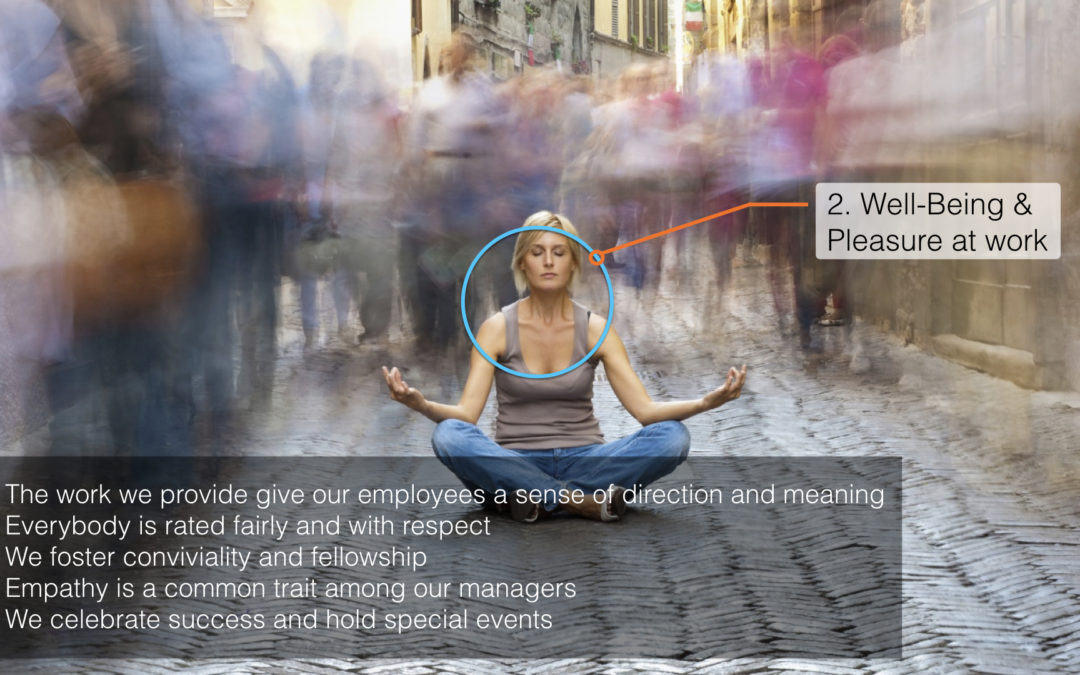According to Benjamin Chaminade, creativity is a four-stage process. The first stage is ‘inspiration’. Therefore, rather than swamp you with different viewpoints and theories, we have decided instead to give you some concrete examples of management innovation practices that have been adopted by companies of different sizes, activities and nationalities. They all have one thing in common: they have succeeded in combining self-fulfilment and performance.
Here are a few innovative practices, ranked in order of importance according to French companies (trust, commitment, wellbeing, agility, collaboration and creativity).
Pleasure and wellbeing
“Choose a job you love, and you will never have to work a day in your life” – Confucius
“It’s true, my job isn’t that exciting, but it puts food on the table”, “I’ve done everything in my job description, now what?”, “My manager doesn’t motivate me”… While 80% of French people claim to be happy with their working conditions (place of work, hours, autonomy…)[iv], only 20% of them actually enjoy their job[v]. Could this be because 46% of French people are not doing the job they would really like to do[vi]?
What interest does a company have in the happiness/fulfilment of its staff?
Before the media coverage surrounding the 2009 suicides at France Télécom, wellbeing in the workplace was of no real concern to managers. And when companies were interested in motivating their staff, it was with the sole aim of increasing their performance and nothing to do with their wellbeing. These sentiments can come across as quite shocking, but in today’s world it is society that serves the economy, not the other way round.
But contrary to what people might think, while improving working conditions may have a direct impact on job satisfaction, it does not necessarily increase job fulfilment.
So who is responsible for staff fulfilment? The company? The employee? Both? In the first instance, it largely depends on what the employee is looking for.
Following our research, we concluded that job fulfilment depends on two main factors:
- The type of activities being undertaken and the responsibilities entrusted
- The friendliness of other staff and a good working atmosphere.
While the company can largely influence the second factor, the first depends largely on how the employee feels about carrying out his day-to-day activities. Therefore you could say that the only factor employees have direct control over is largely an endogenous one (whereas many employees still believe it’s down to the company to make them happy).
This is why wellbeing and enjoyment at work is not the sole responsibility of the employer. Rather, it is a joint responsibility.
Three examples of how wellbeing and enjoyment can be improved in the workplace
- At the Fiat factory, in Brazil, workers let the company know what sort of mood they’re in before starting work each morning.Green signifies that everything is okay, orange that the employee is mildly motivated, and red that there is a problem. Those declaring their mood in the ‘red’ category are then seen by a manager and and HR specialist (around 80% of workers have a ‘red’ day about once a year). This practice is particularly interesting as responsibility for managing individual wellbeing is passed down to the employee (and not to the management).
- At W L Gore, in the United States (with some 8000 employees), new recruits are gifted with a period of a few weeks to get to know the different work activities on offer and to choose the teams which they feel they would like to work with(based on how much they feel they would enjoy the work, and therefore contribute most to). Each company team has the right to refuse applications to join them. This practice clearly highlights two important factors governing job fulfilment, namely interest in the work itself and being part of a group where one feels comfortable.
At Euro Disneyland, in Paris, with approximately 15,000 employees, an ‘Advisory Council’ of sorts has been set up. This is made up of staff (on a volunteer basis) who are charged with finding solutions to minor daily issues flagged up by ‘neighbourhood leaders’ (through established communication channels). This council meets four times a year, and the meetings are run independently to company and management meetings



Recent Comments